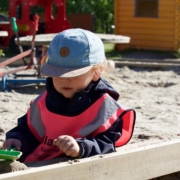Shaping microbial exposures and the immune system in childhood: Can sandboxes be probiotic?
By Prof. Seppo Salminen, University of Turku, Finland
Gut microbiota researchers have established that microbial exposures in early life can be influential on health later in life. Children who develop asthma in early childhood, for example, have an altered gut microbiota linked with exposure to less diverse microorganisms in their first year. The ‘biodiversity hypothesis’ has been advanced recently, suggesting that western lifestyles and low biodiversity in urban environments reduce contact with microbes both via food and via the natural environment, presenting fewer opportunities for children to be exposed to a diversity of microbes in their earliest years and increasing the risk of non-communicable diseases. If this is the case, the environments of daycare and kindergarten facilities come under scrutiny as a source of microbial exposures at a crucial time of life. So is it beneficial to intervene in children’s environments to ensure more diverse microbial exposures? Can we enhance gut microbial diversity and richness in children through environmental interventions?
A new study provided proof that shaping children’s microbial exposures may be possible. The study was the first of its kind – a placebo-controlled, double-blinded study on the effect of environmental exposures on gut microbiota diversity and immune parameters in young children. The study used playground sandboxes at daycare facilities as sources of environmental microbial diversity and explored whether these could have effects on the children.
Six day-care centers in southern Finland were enrolled in the study, with two randomly assigned to intervention and four to placebo. Identical-looking playground sandboxes were used. Intervention sandboxes were filled with sand of glacial origin enriched with a known biodiversity powder (including commercial soil, deciduous leaf litter, peat, and Sphagnum moss; described in detail by Hui et al., 2019 ; Grönroos et al, 2018). In control centers the sand was regular sandbox sand and placebo peat material. Altogether, 26 children ages 3-5 participated in supervised play for 20 minutes in the morning and afternoon for two weeks. Researchers measured the composition of gut and skin microbiota, as well as blood immune markers.
The results demonstrated that exposure to diverse environmental microbiota enhanced both the bacterial richness and diversity of the skin bacterial community. The microbiome of the skin changed only in those children who had played in a sandbox enriched with natural materials. The authors also found that the daily exposure to higher microbial biodiversity resulted in positive differences in immune response. For instance, the authors reported shifts in skin microbiota associated with IL-10 and T cell frequencies. This provides the first evidence from a placebo-controlled, double-blinded study in young children showing the differential effects on microbiota and immunity of daily exposure to defined microbial biodiversity.
An interesting follow-up could be using sandboxes to deliver probiotics with a proven health impact to children. Since the sandbox microbes were shown to influence children’s immune systems, could researchers go one step further and modulate children’s microbiota in a targeted manner? A probiotic must be defined, shown to have a health benefit and administered in an efficacious dose. In the case of sandboxes, the health benefit would need to be demonstrated for a certain level or duration of environmental exposure.
Playgrounds and sandboxes require materials that tolerate heavy wear and tear and are safe at the same time. Such materials need to be kept free of unnecessary contamination as sandboxes, for example, can also be good reservoirs of some detrimental bacteria. Therefore, it could be important to have defined natural materials for a positive impact on health. In the future, we may see many creative approaches to ensuring children receive appropriate health-supporting microbial exposures early in life. However, creating probiotic approaches requires identification of specific microbes in the biodiversity powder.





